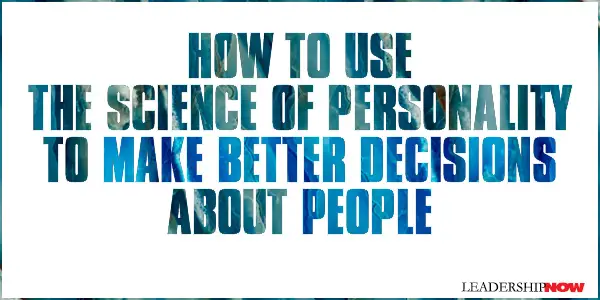 |
 |
07.26.24

How to Use the Science of Personality to Make Better Decisions About People
SOME of the biggest decisions we will make involve judgments about people—who to hire, who to marry, which friends to have, what job to take, or which business partner to take on. Good people judgment becomes a critical skill in all aspects of life. There are hundreds of ways to describe someone’s observable behavior. On the whole, these can be cumbersome and confusing. Instead, organizational psychologist Richard Davis writes in Good Judgment: Making Better Business Decisions with the Science of Human Personality we can use a manageable personality framework that allows us to identify patterns of behavior and quantifiable characteristics according to an individual’s personality traits. Research into human behavior has determined that we can distill personality down to just a handful of five traits called the Big Five: Openness, Conscientiousness, Extroversion, Agreeableness, and Neuroticism. As the science shows, we can describe our personality as a function of all five dimensions. We tend to be higher or lower in certain dimensions than in others, and we also tend to manifest specific traits differently in our behavior. Even so, the Big Five are not enough, and no personality test can capture the complexity of human behavior. As Davis states, “It’s one thing to understand whether a person has a given trait, quite another to know how that person will express that trait in their actual behavior, which is what we ultimately care about.” Using the Big Five as a guide, Davis has constructed a personality blueprint for judging character. The five categories briefly explained are: 1. Intellect — How People Think
2. Emotionality — How People Express Emotions
3. Sociability — How People Engage with Others
4. Drive — Why People Do What They Do
5. Diligence — How People Get Stuff Done
These five categories are not independent but come together to make up who a person is. Context matters. “The specific ways that individuals express their personality traits also help to determine if those traits are helpful or disruptive. So much rides not just on the specific traits people appear to express but on their ability to master whether and how they express them in everyday situations. Personality isn’t permanent as described here. We can decide to push back against our latent tendencies if we wish, disciplining ourselves to behave differently and developing workarounds. So, how do we use this information? Casual conversations work well for understanding others’ personalities if you know how to conduct them. Like a journalist conducting an interview, we can employ five strategies to enhance our perception: build rapport, get people to talk about their past, ask power questions, interpret what you are learning and how it fits into one of the five categories, and calibrate the interpretation to the context and the way they present themselves. Consider too your own biases when judging others. And above all, be curious. Davis details each of these strategies, the questions we should be asking, and how we might best interpret the information we gather. 
Posted by Michael McKinney at 04:51 PM
|
BUILD YOUR KNOWLEDGE
 

How to Do Your Start-Up Right STRAIGHT TALK FOR START-UPS 
Grow Your Leadership Skills NEW AND UPCOMING LEADERSHIP BOOKS 
Leadership Minute BITE-SIZE CONCEPTS YOU CAN CHEW ON 
Classic Leadership Books BOOKS TO READ BEFORE YOU LEAD |